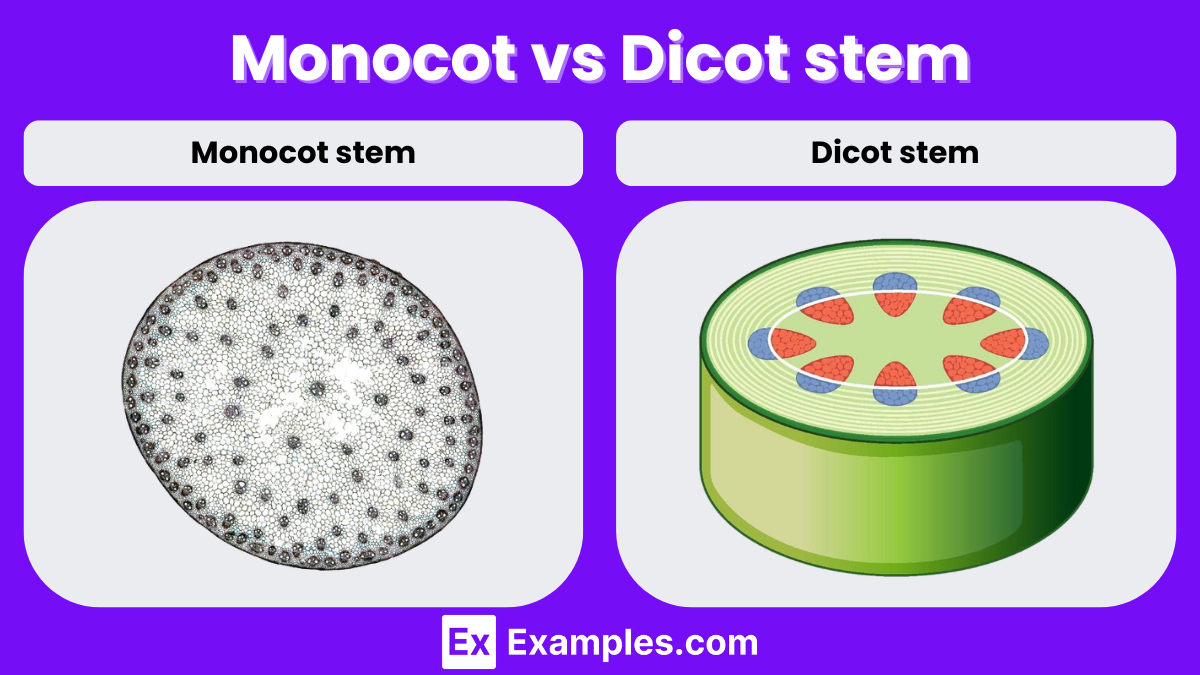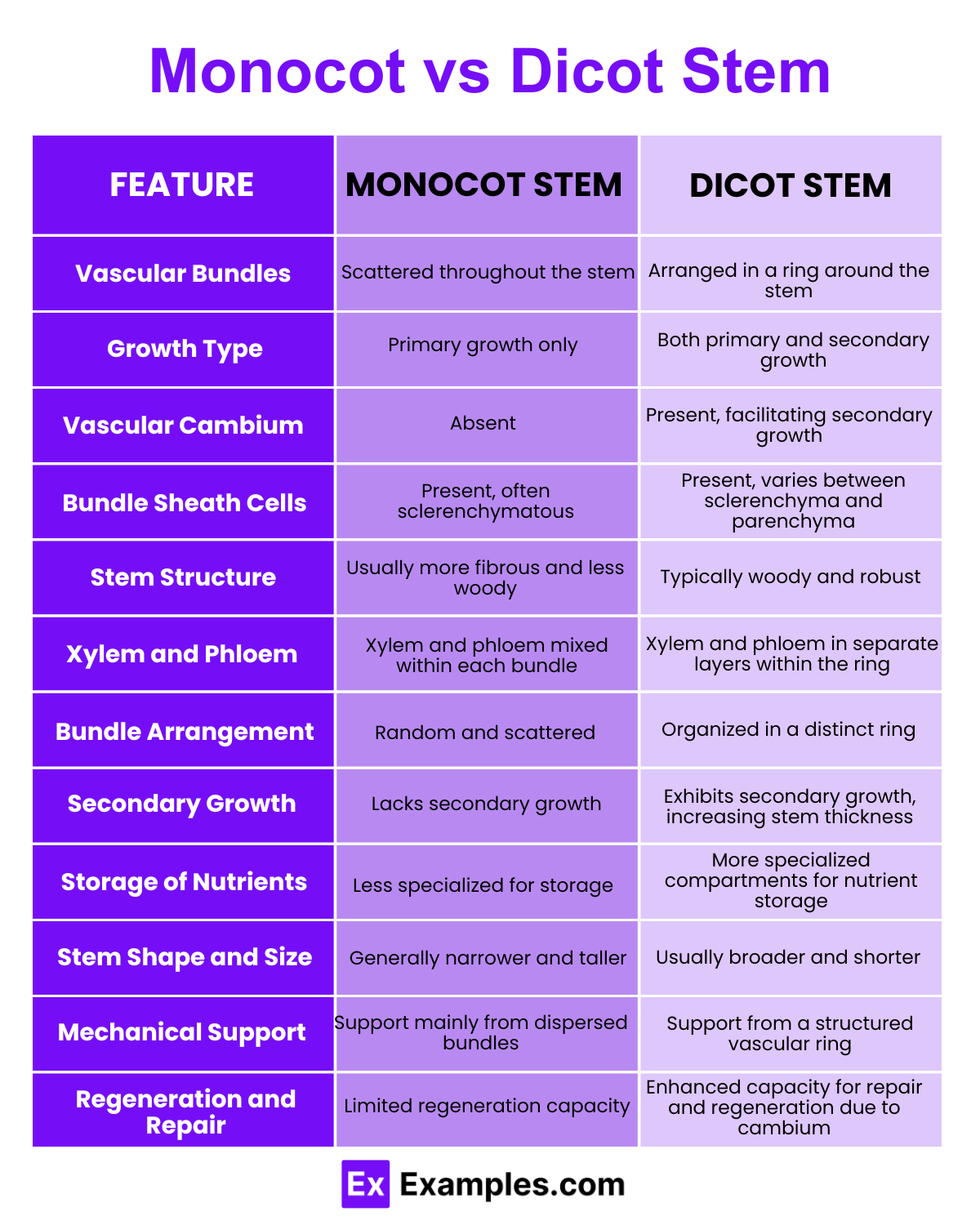Which of the following characteristics is typical of a monocot stem?
Vascular bundles arranged in a ring
Vascular bundles scattered throughout the stem
Presence of a vascular cambium
Presence of a pith


Exploring the diverse world of plant biology, one fundamental distinction captures the attention of botanists and educators alike: the difference between monocot and dicot stems. This comparison not only highlights the unique architectural frameworks of these plants but also sheds light on their evolutionary adaptations. Monocot stems, characterized by scattered vascular bundles, cater to the life strategies of grasses and lilies. In contrast, dicot stems exhibit a more organized arrangement with vascular bundles forming a distinct ring, typical of broadleaf plants.
Monocot stems, integral to monocotyledonous plants, distinguish themselves through several unique structural and functional features. Found in a variety of plants such as grasses, lilies, and palms, these stems are adapted to support a range of environments and growth forms.
One of the defining features of monocot stems is the arrangement of their vascular bundles, the transport channels for water, minerals, and nutrients. Unlike dicots, monocots have vascular bundles that are scattered throughout the stem’s cross-section. This scattered arrangement contributes to the plant’s strength and flexibility, important for withstanding various environmental stresses such as wind.
Monocot stems typically do not undergo secondary growth; they do not have a vascular cambium between the xylem and phloem. As a result, these plants do not thicken over time like woody dicots but rather maintain a consistent diameter throughout their lifespan. This characteristic limits their growth predominantly to increases in height rather than girth.
The ground tissue in monocot stems is primarily made up of parenchyma cells, which fill the spaces between the vascular bundles. These cells are essential for storing nutrients and also play a role in photosynthesis and wound healing. The presence of extensive parenchyma makes the stems lighter and more flexible.
Dicot stems form the backbone of dicotyledonous plants, featuring distinct structural characteristics that support a wide range of growth forms from small herbs to large trees. These stems are essential in facilitating various physiological processes, contributing to the plant’s overall development and survival.
In dicot stems, vascular bundles are organized in a ring around the periphery of the stem, contrasting with the scattered arrangement seen in monocots. This ring formation allows for the differentiation of tissues into inner and outer regions, facilitating efficient transport and structural support.
One of the hallmark features of dicot stems is their capacity for secondary growth, which involves the thickening of the stems and roots. This growth is mediated by the vascular cambium and cork cambium, which produce new vascular tissues and protective bark, respectively. Secondary growth enables dicots to develop woody tissues, contributing to the thick, sturdy structures capable of supporting large trees.
The xylem and phloem in dicot stems are well-organized, with xylem typically located towards the interior and phloem towards the exterior. The xylem helps in water transportation and structural support, while the phloem distributes nutrients produced through photosynthesis across different parts of the plant.

| Feature | Monocot Stem | Dicot Stem |
|---|---|---|
| Vascular Bundle Arrangement | Scattered throughout the stem | Arranged in a ring around the periphery of the stem |
| Vascular Bundles | Usually numerous and closed (no cambium) | Fewer, open (with cambium allowing secondary growth) |
| Stem Growth | Primary growth only, typically no thickening | Both primary and secondary growth, allowing thickening |
| Xylem and Phloem | Xylem and phloem in each bundle are interspersed | Xylem is usually internal to phloem in each bundle |
| Pith | Large and well developed | Smaller, often located centrally |
| Cortex | Generally thin | Thicker and well defined |
| Epidermis | Usually has a thick cuticle and may have silica | Thinner cuticle compared to monocots |
| Fibers | Fibers often present around vascular bundles | Fibers may be absent or not associated with bundles |
| Bundle Sheath Cells | Usually large and conspicuous | Smaller and less conspicuous |
| Mechanical Support | Support mainly through leaf sheaths | Woody structure provides mechanical support |
| Secondary Metabolites | Fewer secondary metabolites like tannins | Often contain more types of secondary metabolites |
| Interfascicular Cambium | Absent | Present between vascular bundles forming a complete ring |
| Leaf Traces | Multiple leaf traces per node, complex | Usually one or two leaf traces per node, simpler |
| Root System | Fibrous root system originates from stem tissues | Taproot system with roots originating from radicle |
| Role in Ecosystem | Typically adapted to fast growth in open, disturbed areas | Often structured for longevity and complex ecosystems |
| Stem Shape | Often round with a more uniform diameter | Often irregular, can be fluted or tapered |
| Nodal Anatomy | Nodes tend to be less distinct | Nodes are often more pronounced and swollen |
| Internodes | Longer internodes | Shorter internodes |
| Stem Texture | Typically softer and less woody | Harder, woody texture especially in older growth |
| Periderm Development | Rarely develops a periderm; maintains epidermis longer | Develops a periderm, replaces epidermis in older stems |
| Lenticels | Rare or absent | Frequently present, aiding in gas exchange |
| Storage of Nutrients | Less common, storage mainly in roots or leaves | Common, with storage capabilities in both roots and stems |
Both monocot and dicot stems contain the three primary tissues essential for plant life: dermal, vascular, and ground tissues. The dermal tissue serves as a protective outer layer, the vascular tissue (comprising xylem and phloem) is responsible for water and nutrient transport, and the ground tissue fills the spaces between and supports these systems.
In both types of stems, vascular bundles, which include xylem and phloem, are critical for transporting water, nutrients, and sugars throughout the plant. Although their arrangement might differ (scattered in monocots and usually ring-shaped in dicots), the presence of these bundles is a universal feature.
Monocot and dicot stems both possess apical meristems at their tips. These regions of actively dividing cells are crucial for the vertical growth of the plant, allowing the stem to extend and the plant to increase in height.
A cuticle, which is a waxy protective layer on the surface of the stem, is common to both monocot and dicot stems. This layer helps prevent water loss through evaporation, offering an essential survival advantage in various environmental conditions.
Both types of stems are composed of fundamental cell types including parenchyma, collenchyma, and sclerenchyma. These cells play roles in storage, structural support, and strength, respectively. Their presence is vital for the mechanical support and integrity of the plant.
Both monocot and dicot stems are capable of primary growth, which involves elongation of the stem and is primarily driven by the apical meristems. This type of growth is critical for the plant as it first establishes height and reach during the early stages of development.
Finally, both monocot and dicot stems may contain chloroplasts in their cells, particularly when they are young and green. This enables them to perform photosynthesis, which is essential for the plant’s production of energy and survival.
Monocot stems have scattered vascular bundles; dicot stems feature a ring-shaped arrangement of bundles.
Monocot stems usually lack secondary growth due to the absence of a cambium layer.
In monocot stems, you find numerous, closed vascular bundles interspersed with xylem and phloem.
Yes, a monocot stem typically has a thick cuticle, often reinforced with silica.
A monocot stem is part of a monocotyledon plant, featuring scattered vascular bundles and primary growth only.
Text prompt
Add Tone
10 Examples of Public speaking
20 Examples of Gas lighting
Which of the following characteristics is typical of a monocot stem?
Vascular bundles arranged in a ring
Vascular bundles scattered throughout the stem
Presence of a vascular cambium
Presence of a pith
In dicot stems, the vascular bundles are:
Scattered randomly
Arranged in a ring
Absent
Present only at the periphery
Which plant is an example of a monocot?
Bean
Rose
Corn
Oak
In dicot stems, secondary growth is made possible by:
Apical meristem
Vascular cambium
Ground tissue
Epidermis
Which of the following is a typical characteristic of dicot stems but not monocot stems?
Scattered vascular bundles
Secondary growth
Presence of pith
Parallel venation in leaves
The vascular bundles in monocot stems are:
Open and capable of secondary growth
Closed and scattered
Arranged in concentric circles
Only present near the periphery
Which of the following plants is a dicot?
Wheat
Bamboo
Sunflower
Rice
Monocot stems typically lack:
Vascular bundles
Ground tissue
Secondary growth
Epidermis
In dicot stems, the xylem and phloem are arranged:
In scattered bundles
In concentric rings
Side by side in a ring
Randomly distributed
What type of leaf venation is associated with dicots?
Parallel venation
Reticulate venation
Spiral venation
None
Before you leave, take our quick quiz to enhance your learning!

